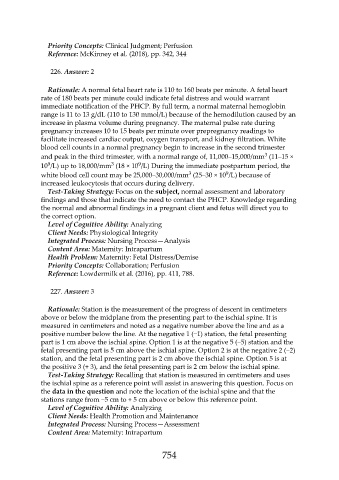Page 754 - Saunders Comprehensive Review For NCLEX-RN
P. 754
Priority Concepts: Clinical Judgment; Perfusion
Reference: McKinney et al. (2018), pp. 342, 344
226. Answer: 2
Rationale: A normal fetal heart rate is 110 to 160 beats per minute. A fetal heart
rate of 180 beats per minute could indicate fetal distress and would warrant
immediate notification of the PHCP. By full term, a normal maternal hemoglobin
range is 11 to 13 g/dL (110 to 130 mmol/L) because of the hemodilution caused by an
increase in plasma volume during pregnancy. The maternal pulse rate during
pregnancy increases 10 to 15 beats per minute over prepregnancy readings to
facilitate increased cardiac output, oxygen transport, and kidney filtration. White
blood cell counts in a normal pregnancy begin to increase in the second trimester
3
and peak in the third trimester, with a normal range of, 11,000–15,000/mm (11–15 ×
9
3
9
10 /L) up to 18,000/mm (18 × 10 /L) During the immediate postpartum period, the
3
9
white blood cell count may be 25,000–30,000/mm (25–30 × 10 /L) because of
increased leukocytosis that occurs during delivery.
Test-Taking Strategy: Focus on the subject, normal assessment and laboratory
findings and those that indicate the need to contact the PHCP. Knowledge regarding
the normal and abnormal findings in a pregnant client and fetus will direct you to
the correct option.
Level of Cognitive Ability: Analyzing
Client Needs: Physiological Integrity
Integrated Process: Nursing Process—Analysis
Content Area: Maternity: Intrapartum
Health Problem: Maternity: Fetal Distress/Demise
Priority Concepts: Collaboration; Perfusion
Reference: Lowdermilk et al. (2016), pp. 411, 788.
227. Answer: 3
Rationale: Station is the measurement of the progress of descent in centimeters
above or below the midplane from the presenting part to the ischial spine. It is
measured in centimeters and noted as a negative number above the line and as a
positive number below the line. At the negative 1 (−1) station, the fetal presenting
part is 1 cm above the ischial spine. Option 1 is at the negative 5 (−5) station and the
fetal presenting part is 5 cm above the ischial spine. Option 2 is at the negative 2 (−2)
station, and the fetal presenting part is 2 cm above the ischial spine. Option 5 is at
the positive 3 (+ 3), and the fetal presenting part is 2 cm below the ischial spine.
Test-Taking Strategy: Recalling that station is measured in centimeters and uses
the ischial spine as a reference point will assist in answering this question. Focus on
the data in the question and note the location of the ischial spine and that the
stations range from −5 cm to + 5 cm above or below this reference point.
Level of Cognitive Ability: Analyzing
Client Needs: Health Promotion and Maintenance
Integrated Process: Nursing Process—Assessment
Content Area: Maternity: Intrapartum
754

